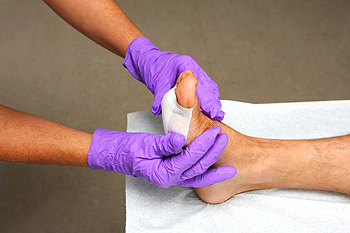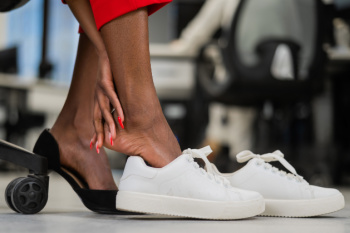Connect With Us
Blog
Items filtered by date: August 2024
Foot Wounds Among the Elderly

Foot wound care is essential for everyone, but it is particularly important for the elderly, who are at a higher risk due to drier skin and a greater likelihood of dehydration. Regularly checking feet for any cuts, blisters, or signs of infection is important. Applying moisturizer helps keep the skin supple, reducing the risk of skin tears, a common issue in this age group. Pressure ulcers and diabetic wounds also require close attention, as these can easily become serious if left untreated. Staying hydrated is important for overall skin health, so encourage regular water intake. If a wound shows signs of infection, such as redness, warmth, swelling, or pus, it is vital to consult a podiatrist promptly to prevent complications. Early intervention and proper care can make all the difference in maintaining foot health. If you are elderly or are taking care of a senior, it is suggested that you consult a podiatrist if any foot wounds need special care.
Wound care is an important part in dealing with diabetes. If you have diabetes and a foot wound or would like more information about wound care for diabetics, consult with one of our podiatrists from Save Your Soles. our doctors will assess your condition and provide you with quality foot and ankle treatment.
What Is Wound Care?
Wound care is the practice of taking proper care of a wound. This can range from the smallest to the largest of wounds. While everyone can benefit from proper wound care, it is much more important for diabetics. Diabetics often suffer from poor blood circulation which causes wounds to heal much slower than they would in a non-diabetic.
What Is the Importance of Wound Care?
While it may not seem apparent with small ulcers on the foot, for diabetics, any size ulcer can become infected. Diabetics often also suffer from neuropathy, or nerve loss. This means they might not even feel when they have an ulcer on their foot. If the wound becomes severely infected, amputation may be necessary. Therefore, it is of the upmost importance to properly care for any and all foot wounds.
How to Care for Wounds
The best way to care for foot wounds is to prevent them. For diabetics, this means daily inspections of the feet for any signs of abnormalities or ulcers. It is also recommended to see a podiatrist several times a year for a foot inspection. If you do have an ulcer, run the wound under water to clear dirt from the wound; then apply antibiotic ointment to the wound and cover with a bandage. Bandages should be changed daily and keeping pressure off the wound is smart. It is advised to see a podiatrist, who can keep an eye on it.
If you have any questions, please feel free to contact our offices located in Abington and Willow Grove, PA . We offer the newest diagnostic and treatment technologies for all your foot care needs.
What to Do About Heel Pain
 Heel pain is often caused by plantar fasciitis, an inflammation of the tissue running along the bottom of the foot. Other causes include Achilles tendinitis, heel spurs, or repetitive stress injuries. Contributing factors for heel pain can be excessive walking or standing, wearing improper footwear, obesity, or flat feet. To manage heel pain, rest and avoid activities that aggravate the condition. Performing stretching exercises and using supportive footwear or orthotic inserts can provide relief. Mild pain relievers may help reduce inflammation and pain. If you have heel pain and symptoms persist, it is suggested that you consult a podiatrist for a thorough evaluation and treatment plan.
Heel pain is often caused by plantar fasciitis, an inflammation of the tissue running along the bottom of the foot. Other causes include Achilles tendinitis, heel spurs, or repetitive stress injuries. Contributing factors for heel pain can be excessive walking or standing, wearing improper footwear, obesity, or flat feet. To manage heel pain, rest and avoid activities that aggravate the condition. Performing stretching exercises and using supportive footwear or orthotic inserts can provide relief. Mild pain relievers may help reduce inflammation and pain. If you have heel pain and symptoms persist, it is suggested that you consult a podiatrist for a thorough evaluation and treatment plan.
Many people suffer from bouts of heel pain. For more information, contact one of our podiatrists of Save Your Soles. our doctors can provide the care you need to keep you pain-free and on your feet.
Causes of Heel Pain
Heel pain is often associated with plantar fasciitis. The plantar fascia is a band of tissues that extends along the bottom of the foot. A rip or tear in this ligament can cause inflammation of the tissue.
Achilles tendonitis is another cause of heel pain. Inflammation of the Achilles tendon will cause pain from fractures and muscle tearing. Lack of flexibility is also another symptom.
Heel spurs are another cause of pain. When the tissues of the plantar fascia undergo a great deal of stress, it can lead to ligament separation from the heel bone, causing heel spurs.
Why Might Heel Pain Occur?
- Wearing ill-fitting shoes
- Wearing non-supportive shoes
- Weight change
- Excessive running
Treatments
Heel pain should be treated as soon as possible for immediate results. Keeping your feet in a stress-free environment will help. If you suffer from Achilles tendonitis or plantar fasciitis, applying ice will reduce the swelling. Stretching before an exercise like running will help the muscles. Using all these tips will help make heel pain a condition of the past.
If you have any questions please contact our offices located in Abington and Willow Grove, PA . We offer the newest diagnostic and treatment technologies for all your foot and ankle needs.
Differences Between Sprinting and Long-Distance Track Spikes in Running Shoes

It is important to wear the right type of running shoes for your desired type of running. Choosing the right track spikes on shoes for running depends significantly on the type of event, whether it be sprinting or long distance. Sprinting spikes are designed for short, explosive bursts of speed. They feature lightweight construction, with stiff plates and minimal cushioning to maximize energy transfer and traction on the track. The spikes themselves are often shorter and more aggressive, providing superior grip for powerful starts and sharp turns. In contrast, long distance spikes prioritize comfort and endurance. They typically have more cushioning and support to absorb impact over extended periods. The spike plate is more flexible to accommodate the natural foot motion of longer races, and the spikes themselves are slightly longer for better grip on varying surfaces. This design helps runners maintain efficiency and reduce fatigue during races that require sustained effort over multiple laps or distances. Wearing shoes that are not designed for your specific type of running may lead to developing painful foot conditions. If this has happened to you, it is suggested that you promptly contact a podiatrist who can treat any foot problem and guide you toward buying appropriate running shoes.
If you are a runner, wearing the right running shoe is essential. For more information, contact one of our podiatrists from Save Your Soles. our doctors can provide the care you need to keep you pain-free and on your feet.
Choosing the Right Running Shoe for Your Foot Type
To increase performance and avoid the risk of injury, it is important to choose the right running shoe based on your foot type. The general design of running shoes revolves around pronation, which is how the ankle rolls from outside to inside when the foot strikes the ground.
- Neutral runners are able to choose from a wide variety of shoes, including minimalist shoes or even going barefoot.
- Runners who overpronate, or experience an over-abundance of ankle rolling, should choose shoes that provide extra motion control and stability.
- Runners who underpronate, or supinate, have feet that have high arches and lack flexibility, preventing shock absorption. They require shoes with more flexibility and cushion.
If you have any questions please feel free to contact our offices located in Abington and Willow Grove, PA . We offer the newest diagnostic and treatment technologies for all your foot and ankle needs.
